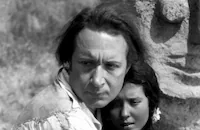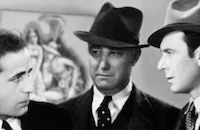Across the Pacific

Brief Synopsis
Cast & Crew
John Huston
Humphrey Bogart
Mary Astor
Sydney Greenstreet
Charles Halton
Sen Young
Film Details
Technical Specs

Synopsis
Rick Leland, a captain in the United States Coast Auxiliary Army, is found guilty of stealing regimental funds and is dishonorably discharged from the service. He subsequently tries to enlist in the Canadian artillery but is turned down because of his record. Disillusioned, Rick buys passage on the Japanese freighter, the Genoa Maru , intending to offer his services to the Chinese. Traveling on the same ship is Alberta Marlow, who is heading for Panama, and Dr. Lorenz and his Japanese servant, T. Oki. Lorenz is a student of Japanese culture and is interested to learn that if war broke out in the Pacific, Rick would not participate. Over drinks, Lorenz quizzes Rick about his experience in the artillery in Panama. Rick also spends some time flirting with Alberta, who returns his interest. When the ship docks in New York City, Rick visits a man who turns out to be his undercover contact. Rick, whose dishonorable discharge was faked to cover his investigation of Lorenz, asks his contact to inquire into Alberta's background, as well. When Rick rejoins the ship, another passenger, Joe Totsuiko, a Nisei, joins the company. On board, Rick prevents a Filipino man from shooting Lorenz, who explains that some Filipinos resent his ties with the Japanese. Alberta later calls Rick's attention to the fact that Lorenz has a new servant who is using the same name as his former servant. Eventually Lorenz offers Rick money to disclose military information and Rick agrees. In Panama, the passengers learn that the ship will not be allowed to travel through the canal. After disembarking, they all check into a hotel. Lorenz demands that Rick find out the schedule of airplanes flying over the area in return for the money he paid him earlier. Rick also learns that Alberta is not who she is pretending to be and confronts her, but just as she is about to explain, she is called to the telephone. Rick then searches her room, where he finds that Lorenz has earlier done the same. Lorenz warns Rick about Alberta before knocking him unconscious. When Rick comes to, he alerts his contact about Lorenz' plans, but the man is killed before he can act on the warning. Sam, the hotel keeper and an old friend of Rick's, puts him in touch with a man who advises him to travel quickly to a nearby plantation. There, workers are loading a bomber under cover of darkness. Rick is captured and taken inside, where he discovers Alberta and Joe. The owner of the plantation is Alberta's father, who has been forced to provide a cover for the Japanese. Lorenz's servant turns out to be a bomber pilot. Now the Japanese, supported by Joe and Lorenz, plan to bomb the canal's locks. Hearing the plane start its engines, Rick initiates a fight, during which Alberta's father is killed. Rick escapes and shoots down the plane, killing the Japanese pilot. His plan a failure, Lorenz tries to kill himself, but cannot go through with it. Rick captures him and takes him in for questioning. Alberta, who has been loyal all along, accompanies Rick.

Cast

Humphrey Bogart

Mary Astor

Sydney Greenstreet

Charles Halton
Sen Young
Roland Got
Lee Tung Foo
Frank Wilcox
Paul Stanton
Lester Matthews

John Hamilton
Tom Stevenson
Roland Drew

Monte Blue
Chester Gan

Richard Loo

Keye Luke
Kam Tong
Spencer Chan
Rudy Robles
William Hopper
Frank Mayo
Garland Smith
Dick French

Charles Drake
Will Morgan

Jack Mower
Frank Faylen
Ruth Ford
Eddie Lee
Dick Botiller
Beal Wong
Philip Ahn

Anthony Caruso
James Leong
Paul Fung
Eddie Dew
Crew
Milo Anderson
Gordon Bau
George Becker
Edward Blatt
Everett A. Brown
Jean Burt
William Conger
Adolph Deutsch
E. F. Dexter
Hal Dunn
Alma Dwight
Arthur Edeson
Leo F. Forbstein
Dan Fujiwara
Jo Graham
Robert Haas
Chuck Hansen
Byron Haskin
Michael Joyce
Lee Katz
Russ Llewellyn
Richard Macaulay
Frank Magee
Armor Marlowe
Wally Meinardus
Hugh Reticker
Casey Roberts
Jack Saper
Don Siegel
William Steudeman
Jeanette Storck
Colonel J. G. Taylor
George Tobin
Willard Van Enger
Jerry Wald
Elaine Waters
Perc Westmore
Jack Woods

Photo Collections
Videos
Movie Clip





Trailer
Hosted Intro
Film Details
Technical Specs

Articles
Across the Pacific
Bogart stars as Rick Leland, a dishonorably discharged soldier who decides to sell his military expertise to the highest bidder beneath the gathering clouds of World War II. Boarding the Genoa Maru, a cargo boat traveling to the Pacific via the Panama Canal, Rick encounters a variety of questionable characters, including the sophisticated but sinister Dr. Lorenz (Sydney Greenstreet), who seems oddly enamored with Japanese culture, and Alberta Marlow (Mary Astor), an alluring woman who is very secretive about her true background. By the time they reach the Panama Canal, Rick has learned of an elaborate plot to destroy the crucial passageway, and realizes he is the only man who can thwart it.
One of the only Maltese Falcon principals missing from Across the Pacific was Peter Lorre, who did make a surprise appearance on the set during production. Without informing his cast, Huston had Lorre enter the background as a waiter, clumsily disrupting the scene until announcing his presence with a wet kiss on the back of Astor's neck.
Serialized in The Saturday Evening Post, Robert Garson's story "Aloha Means Goodbye" originally revolved around a Japanese plot to attack Pearl Harbor. When, near the beginning of production, the American base was actually attacked, the story was quickly revised so that the Panama Canal was made the enemy's new target. "It was kind of a creepy feeling," remembered Mary Astor in her autobiography, "to have been talking about 'the plans of the Japanese' in the picture, and have them practically blueprint our script."
Once war was declared, it was difficult for the crew to hold onto their Japanese American actors, who were suddenly considered a threat to security. According to Astor, "a little indignation and some wire-pulling held them at least until the picture was finished." The Japanese actors were forced to endure a fair amount of racial stereotyping in the wartime film. Most speak pidgin English, while Victor Sen Yung was required to wear grotesque magnifying spectacles. In spite of this thinly disguised racism, Across the Pacific is in many ways respectful of Asian culture and in several instances attempts a serious understanding of the Japanese character and the philosophy of Judo.
Because it was a modestly budgeted film, director Huston devised several ways of adding atmosphere to the studio-bound production. To remind viewers that the characters are on a sea voyage, he had the set of the Genoa Maru's deck constructed on a platform supported by hydraulic lifts so the riggings and the cast were kept in constant motion. In some of the interior cabin sequences, rather than move the set, Huston moved the camera. The camera subtly, almost imperceptibly, edges toward and away from the actors, providing a vaguely disorienting effect that well serves the film's ever-shifting moral ground.
After the Pearl Harbor attack, Huston, like many Hollywood filmmakers, accepted a commission to become a lieutenant in the U.S. Army Signal Corps. He was called into service just prior to the completion of filming Across the Pacific and had to leave it in the hands of another director: Vincent Sherman. As a parting prank on Sherman, Bogart and Warner Bros., Huston concocted a sequence in which Rick is tied to a chair, surrounded by armed Japanese soldiers, in a house which is surrounded by even more soldiers. "There was no way in God's green world that Bogart could logically escape," said Huston. "I shot the scene, then called Jack Warner and said, 'Jack, I'm on my way. I'm in the army. Bogie will know how to get out.'" When Sherman took over as director, he was unable to contrive a plausible means for Rick to escape. Much to the chagrin of the producers, the entire sequence had to be reshot so that Rick was held captive under more lax security.
In the end, Across the Pacific failed to recreate the chemistry of The Maltese Falcon. However, its deft blend of romance and international espionage made it a dry run for a film that would become an undisputed classic. Casablanca (1942) was filmed at Warner Bros. later that year, with Bogart again playing Rick, a cynical expatriate whose national loyalty is tested in the midst of wartime espionage and tempestuous romance.
Director: John Huston
Producer: Jerry Wald, Jack Saper
Screenplay: Richard Macaulay
Based on Aloha Means Goodbye by Robert Garson
Cinematography: Arthur Edeson
Production Design: Robert Haas, Hugh Reticker
Music: Adolph Deutsch
Cast: Humphrey Bogart (Rick Leland), Mary Astor (Alberta Marlow), Sydney Greenstreet (Dr. Lorenz), Victor Sen Yung (Joe Totsuiko), Roland Got (Sugi), Charles Halton (A. V. Smith), Lee Tung Foo (Sam Wing On), Frank Wilcox (Captain Morrison), Monte Blue (Dan Morton).
BW-97m. Closed captioning.
by Bret Wood

Across the Pacific
Quotes
When you're slapped, you're gonna take it and like it.- Rick Leland
Trivia
Director 'Huston, John' went off to join the war effort before the film was finished, and Vincent Sherman directed the final scenes.
This movie was originally about a Japanese plot to blow up Pearl Harbor, but while they were making it, the Japanese actually did blow up Pearl Harbor, so they changed it to the Panama Canal.
Notes
A Warner Bros. press release for this film dated December 1941 included in the file on the film in the AMPAS Library announced that Dennis Morgan and Ann Sheridan were to star. In her autobiography, Mary Astor notes that the original script was about a Japanese invasion of Hawaii, but after the Japanese bombed Pearl Harbor, the location was hastily changed to Panama. The Variety review points out that the title is thus a "misnomer" as none of the action takes place in the Pacific. Production began shortly before the bombing and was closed down and restarted in March 1942. On March 3, 1942, President Franklin D. Roosevelt authorized the internment of Japanese Americans on the West Coast. At that time, Astor reports, the film kept losing its Japanese actors as they were rounded up by the United States government and sent to relocation camps. According to information in the file on the film at the USC Cinema-Television Library, however, Chinese actors were cast as Japanese from the beginning and with the exception of technical advisor Dan Fujiwara and a few bit players, no Japanese participated in the making of the film. As evidenced by the cast credits and as noted by the New Yorker review, Chinese actors played the roles of Japanese spies. Colonel J. G. Taylor acted as technical advisor on the court-martial scenes.
Before the picture was finished, director John Huston was summoned to report to the department of Special Services, and on April 22, 1942 Vincent Sherman took over as director, according to information at USC. In a modern interview, Huston relates that when he knew he was leaving, he filmed a scene in which he tied Humphrey Bogart to a chair with Japanese guards at every window and door and left Sherman to figure out a way to get Bogart's character out of his dilemma. Sherman managed to figure out a solution, but the resulting ending is somewhat implausible. The production finished ten days over schedule. This film marked the reunion of stars Bogart, Greenstreet and Astor and director Huston, who worked together in Warner Bros.' hit film The Maltese Falcon (see below).

Miscellaneous Notes
Released in United States 1942
Released in United States 1942


















